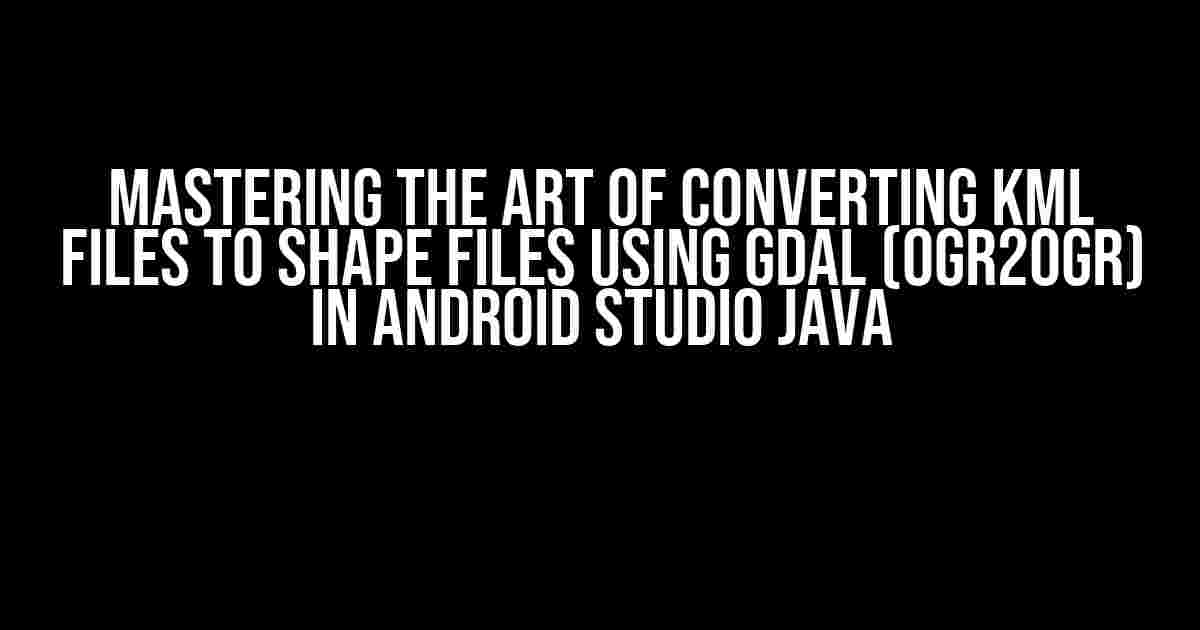Are you tired of struggling with converting KML files to shape files in your Android app development? Look no further! In this comprehensive guide, we’ll take you by the hand and walk you through the process of using GDAL’s ogr2ogr tool to convert KML files to shape files in Android Studio Java.
What is GDAL and ogr2ogr?
GDAL (Geospatial Data Abstraction Library) is an open-source library that allows you to manipulate and analyze geospatial data. ogr2ogr is a command-line tool that comes bundled with GDAL, which enables you to convert between various geospatial data formats, including KML and shape files.
Why Convert KML to Shape Files?
KML (Keyhole Markup Language) is a popular format for representing geospatial data, but it has its limitations. Shape files, on the other hand, are a more versatile and widely-supported format that can be used in a variety of GIS applications. By converting KML files to shape files, you can:
- Access a wider range of GIS tools and software
- Improve data interoperability and compatibility
- Enhance data analysis and visualization capabilities
Setting Up GDAL in Android Studio Java
Before we dive into the conversion process, we need to set up GDAL in Android Studio Java. Follow these steps:
- Download the GDAL library for Android from the official website (https://gdal.org/download.html)
- Extract the downloaded zip file and copy the
gdal.jarfile to your Android project’slibsdirectory - Add the following line to your
build.gradlefile:dependencies { implementation files('libs/gdal.jar') } - Sync your project with Gradle to ensure the changes take effect
Converting KML to Shape Files using ogr2ogr in Android Studio Java
Now that we have GDAL set up, let’s create a Java class to handle the KML to shape file conversion process. Create a new Java class in your Android project, e.g., KMLToShapeConverter.java, and add the following code:
import java.io.BufferedReader;
import java.io.IOException;
import java.io.InputStreamReader;
public class KMLToShapeConverter {
public static void convertKMLToShape(String kmlFilePath, String shapeFilePath) throws IOException {
// Create a command to run ogr2ogr
String command = "ogr2ogr -f \"ESRI Shapefile\" " + shapeFilePath + " " + kmlFilePath;
// Run the command using the Runtime.exec() method
Process process = Runtime.getRuntime().exec(command);
// Read the output and errors streams
BufferedReader output = new BufferedReader(new InputStreamReader(process.getInputStream()));
BufferedReader errors = new BufferedReader(new InputStreamReader(process.getErrorStream()));
// Print the output and errors to the console
String line;
while ((line = output.readLine()) != null) {
System.out.println(line);
}
while ((line = errors.readLine()) != null) {
System.out.println(line);
}
// Wait for the process to finish
process.waitFor();
}
}
This class takes two parameters: kmlFilePath, the path to the KML file, and shapeFilePath, the desired path for the output shape file.
Example Usage
To use the KMLToShapeConverter class, simply call the convertKMLToShape() method, passing in the paths to the input KML file and the desired output shape file:
KMLToShapeConverter.convertKMLToShape("/path/to/input.kml", "/path/to/output.shp");
Troubleshooting Common Issues
When working with GDAL and ogr2ogr, you may encounter some common issues. Here are some troubleshooting tips:
| Error Message | Solution |
|---|---|
| “GDAL not found” or “ogr2ogr not found” | Ensure that the GDAL library is correctly added to your Android project and that the gdal.jar file is in the correct location. |
| “KML file not found” or “Shape file not found” | Verify that the file paths are correct and that the files are in the correct location. |
| “Conversion failed” or “ogr2ogr failed” | Check the KML file for errors or invalid geometry. Try re-running the conversion process with a different KML file or shape file format. |
Conclusion
In this article, we’ve covered the process of converting KML files to shape files using GDAL’s ogr2ogr tool in Android Studio Java. By following these steps and using the provided Java class, you should be able to successfully convert KML files to shape files in your Android app development. Remember to troubleshoot common issues and adjust the conversion process as needed to suit your specific use case.
Happy coding!
Frequently Asked Question
Get answers to your burning questions on how to convert KML files into shape files using GDAL (ogr2ogr) in Android Studio Java!
What is GDAL and how does it relate to converting KML files?
GDAL (Geospatial Data Abstraction Library) is a powerful open-source library that allows you to manipulate and convert geospatial data formats. One of its tools, ogr2ogr, is specifically designed to convert KML files into shape files, which can be used in various GIS applications. In the context of Android Studio, we can utilize the GDAL library to convert KML files into shape files, making it possible to work with geospatial data in our Android apps.
How do I install the GDAL library in Android Studio?
To install the GDAL library in Android Studio, you’ll need to add the GDAL dependency to your app’s build.gradle file. You can do this by adding the following line: `implementation ‘mil.nga.gdal:gdal:3.2.0’`. Then, sync your project with the Gradle files and you’re good to go!
What is the ogr2ogr command to convert a KML file to a shape file?
The ogr2ogr command to convert a KML file to a shape file is: `ogr2ogr -f “ESRI Shapefile” output.shp input.kml`. This command tells ogr2ogr to convert the input.kml file into an output.shp file, which is a shape file.
How do I implement the GDAL library in my Android app to convert KML files?
To implement the GDAL library in your Android app, you’ll need to create a Java class that executes the ogr2ogr command using the Runtime.getRuntime().exec() method. You can then use this class to convert KML files to shape files within your app. Here’s a sample code snippet to get you started:
“`java
Runtime runtime = Runtime.getRuntime();
String command = “ogr2ogr -f \”ESRI Shapefile\” output.shp input.kml”;
Process process = runtime.exec(command);
“`
What are some common errors I might encounter when using GDAL in Android Studio?
Some common errors you might encounter when using GDAL in Android Studio include issues with dependency conflicts, missing dependencies, or incorrect command syntax. Make sure to check your build.gradle file for any errors, and ensure that you’re using the correct ogr2ogr command syntax. Additionally, be aware of any Android OS restrictions on executing system commands, as this might affect the GDAL library’s performance.
I hope this helps!


